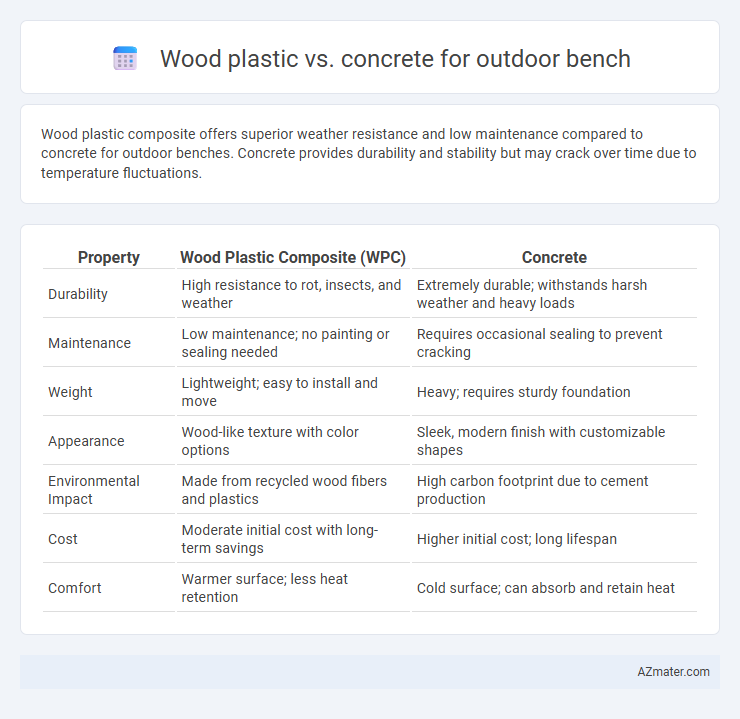Wood plastic composite offers superior weather resistance and low maintenance compared to concrete for outdoor benches. Concrete provides durability and stability but may crack over time due to temperature fluctuations.
Table of Comparison
| Property | Wood Plastic Composite (WPC) | Concrete |
|---|---|---|
| Durability | High resistance to rot, insects, and weather | Extremely durable; withstands harsh weather and heavy loads |
| Maintenance | Low maintenance; no painting or sealing needed | Requires occasional sealing to prevent cracking |
| Weight | Lightweight; easy to install and move | Heavy; requires sturdy foundation |
| Appearance | Wood-like texture with color options | Sleek, modern finish with customizable shapes |
| Environmental Impact | Made from recycled wood fibers and plastics | High carbon footprint due to cement production |
| Cost | Moderate initial cost with long-term savings | Higher initial cost; long lifespan |
| Comfort | Warmer surface; less heat retention | Cold surface; can absorb and retain heat |
Introduction to Outdoor Bench Materials
Wood plastic composites (WPC) and concrete represent two popular materials for outdoor benches, each offering unique benefits and challenges. WPC blends recycled wood fibers and plastic, providing enhanced durability, low maintenance, and resistance to moisture and insects, making it suitable for diverse weather conditions. Concrete benches deliver superior strength, stability, and longevity with minimal upkeep, though they can be heavier and less flexible in design compared to WPC alternatives.
Overview of Wood Plastic Composites
Wood plastic composites (WPCs) are engineered materials composed of wood fibers and thermoplastics, offering enhanced durability and resistance to rot, moisture, and insects compared to traditional wood. These composites provide low maintenance requirements and superior weather resistance, making them ideal for outdoor bench applications where exposure to elements is a concern. WPC benches typically offer a sustainable alternative with recycled content, combining aesthetic appeal and long-term performance in outdoor settings.
Key Features of Concrete Benches
Concrete benches offer exceptional durability and resistance to weather, making them ideal for outdoor environments exposed to rain, sun, and temperature fluctuations. Their heavy weight provides stability and vandal resistance, while their low maintenance requirements ensure long-term usability without frequent repairs or refinishing. Concrete also allows for versatile design options, including various textures and finishes that can mimic natural stone or incorporate decorative elements.
Durability Comparison: Wood Plastic vs Concrete
Wood plastic composite (WPC) benches offer superior resistance to moisture, rot, and insect damage compared to traditional wood, making them highly durable in outdoor environments. Concrete benches provide exceptional strength and longevity but are prone to cracking under freeze-thaw cycles and require maintenance to prevent surface erosion. Wood plastic exhibits better flexibility and impact resistance, whereas concrete excels in load-bearing capacity but may degrade faster in harsh climates due to weathering effects.
Weather Resistance and Maintenance
Wood plastic composite (WPC) offers superior weather resistance compared to concrete, as it resists moisture, rot, and insect damage without cracking or fading under sunlight exposure. Concrete benches require sealing and regular maintenance to prevent surface deterioration caused by freeze-thaw cycles and water absorption. WPC requires minimal upkeep, typically only periodic cleaning, making it a low-maintenance option for outdoor settings exposed to varying weather conditions.
Aesthetics and Design Flexibility
Wood plastic composite (WPC) offers greater design flexibility and a natural wood-like appearance, allowing for diverse styles and intricate detailing in outdoor benches. Concrete provides a robust, modern aesthetic with a variety of finishes and color options but lacks the warm, organic look of wood plastic. WPC's ability to mimic textures and its lightweight nature make it ideal for customized, visually appealing benches in various outdoor settings.
Installation and Weight Considerations
Wood plastic composite benches offer lighter weight and easier installation compared to concrete benches, making them ideal for quick setup and relocation. Concrete benches require heavy machinery for placement due to their substantial weight, increasing installation time and labor costs. The reduced weight of wood plastic composites also minimizes the need for reinforced foundations, enhancing flexibility in outdoor settings.
Environmental Impact and Sustainability
Wood plastic composites (WPC) offer enhanced environmental benefits over concrete due to their use of recycled plastics and wood fibers, reducing landfill waste and conserving natural resources. Concrete production generates significant CO2 emissions and depletes non-renewable materials, contributing to higher environmental impact. WPC benches are typically more sustainable as they require less energy-intensive manufacturing and provide longer durability with lower maintenance.
Cost Analysis: Initial Investment and Longevity
Wood plastic composite (WPC) benches typically require a higher initial investment than concrete due to material and manufacturing costs, but they offer greater durability against weather, reducing maintenance expenses over time. Concrete benches boast lower upfront costs and strong structural integrity, yet they may incur additional expenses from cracking and surface repairs in harsh climates. Evaluating total cost of ownership, WPC benches tend to be more cost-effective long-term through enhanced longevity and minimal upkeep compared to concrete.
Choosing the Best Material for Your Outdoor Bench
Wood plastic composites (WPC) offer superior resistance to weather, insects, and rot compared to traditional concrete, making them a low-maintenance option for outdoor benches. Concrete benches provide exceptional durability and a heavy, stable structure, ideal for high-traffic areas and public parks. Selecting the best material depends on factors like desired aesthetics, maintenance commitment, and environmental conditions, with WPC favored for versatility and concrete for longevity.

Infographic: Wood plastic vs Concrete for Outdoor bench
 azmater.com
azmater.com